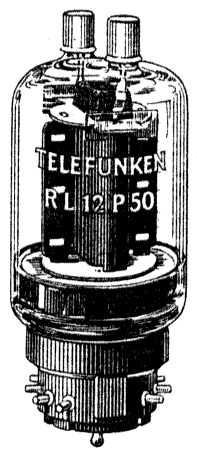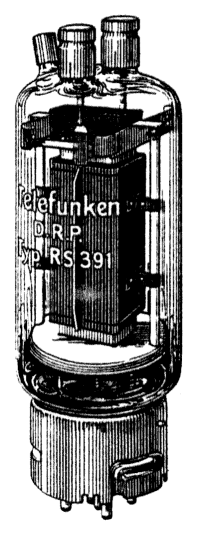|
|---|
| 1 |
Overview |
| 1.1 |
Single Triodes |
| 1.2 |
Multiple Triodes |
| 1.3 |
Tetrodes and Pentodes |
| 1.4 |
Dual Tetrodes and Dual Pentodes |
| 1.5 |
Hexodes and other Multigrid Tubes |
| 1.6 |
Dissimilar Multi-Unit Tubes |
| 1.7 |
Diodes, Rectifiers, and Thyratrons |
| 1.8 |
Voltage Stabilizers - Neon Valves |
| 1.9 |
Electron-Ray Indicators and Display Tubes - Radiation Emitters and Detectors |
| 1.10 |
Microwave Tubes |
|
|---|
| 1.7 |
Diodes, Rectifiers, and Thyratrons |
| 1.7.1 |
Vacuum Diodes and Rectifiers |
| 1.7.2 |
High-Voltage Rectifiers |
| 1.7.3 |
Gas-Filled Diodes and Rectifiers |
| 1.7.4 |
Thyratron Triodes |
| 1.7.5 |
Thyratron Tetrodes and Pentodes |
|
|---|
| 1.9 |
Electron-Ray Indicators and Display Tubes - Radiation Emitters and Detectors |
| 1.9.1 |
Tuning Indicators - Magic Eyes |
| 1.9.2 |
Oscilloscope Cathode Ray Tubes with Static Deflection |
| 1.9.6 |
Numerical Indicator Tubes - Nixies® |
| 1.9.7 |
Photo Tubes |
|
|---|
| 2 |
Class-A Amplifier Static Characteristics |
| 2.1 |
Single Triodes |
| 2.2 |
Multiple Triodes |
| 2.3 |
Triodes of Multi-Unit Tubes |
| 2.4 |
Triode-Connected Tetrodes and Pentodes |
| 2.5 |
Tetrodes and Pentodes |
| 2.6 |
Dual Tetrodes and Dual Pentodes |
| 2.7 |
Tetrodes and Pentodes of Multi-Unit Tubes |
| 2.8 |
Hexodes and other Multigrid Tubes |
|
|---|
| 2.1 |
Single Triodes |
| 2.1.1 |
General-Purpose Types |
| 2.1.4 |
High-Voltage Shunt-Stabilizer Triodes |
| 2.1.5 |
Directly-Heated Triodes for Battery Supply |
| 2.1.8 |
Transmitting Tubes |
|
|---|
| 2.5 |
Tetrodes and Pentodes |
| 2.5.1 |
Indirectly-Heated, Small-Signal, Sharp-Cutoff Types |
| 2.5.2 |
Remote-Cutoff Tetrodes and Pentodes |
| 2.5.3 |
High-Transconductance Wideband Pentodes |
| 2.5.4 |
Dual-Control Pentodes |
| 2.5.5 |
Directly-Heated Tetrodes and Pentodes for Battery Supply |
| 2.5.6 |
Electrometer Tetrodes and Pentodes |
| 2.5.7 |
Power Amplifier Tetrodes and Pentodes |
| 2.5.8 |
Transmitting Tubes |
|
|---|
| 3 |
Resistance-Coupled, Audio-Frequency Voltage Amplifiers |
| 3.1 |
Triodes |
| 3.2 |
Phase Splitters - Phase Inverters |
| 3.4 |
Triode-Connected Pentodes |
| 3.5 |
Tetrodes und Pentodes |
|
|---|
| 3.5 |
Tetrodes und Pentodes |
| 3.5.1 |
Constant-Gain Amplifier Stages |
| 3.5.2 |
Variable-Gain Amplifier Stages |
|
|---|
| 4 |
Audio Power Amplifier Characteristics |
| 4.1 |
Single-Ended Triode |
| 4.2 |
Push-Pull Triodes |
| 4.3 |
Single-Ended Triode-Connected Tetrode or Pentode |
| 4.4 |
Push-Pull Triode-Connected Tetrodes and Pentodes |
| 4.5 |
Single-Ended Tetrode or Pentode |
| 4.6 |
Push-Pull Tetrodes and Pentodes (-->6.6) |
|
|---|
| 4.6 |
Push-Pull Tetrodes and Pentodes |
| 4.6.1 |
Circuits Using Output Transformers |
| 4.6.2 |
Ultra-Linear Output Stages |
| 4.6.3 |
Output-Transformerless Circuits |
| 4.6.4 |
Circuits with Directly-Heated Tubes Using Output Transformers |
|
|---|
| 5 |
Amateur Radio Transmitting Amplifiers |
| 5.1 |
Triodes |
| 5.2 |
Twin Triodes Push-Pull Amplifiers |
| 5.3 |
SSB Linear Amplifiers Using Triodes |
| 5.4 |
Triode-Connected Tetrodes and Pentodes |
| 5.5 |
Tetrodes and Pentodes |
| 5.6 |
Dual Tetrodes and Dual Pentodes |
| 5.7 |
Push-Pull Amplifiers Using Tetrodes and Pentodes |
| 5.8 |
SSB Linear Amplifiers Using Tetrodes and Pentodes |
|
|---|
| 6 |
Miscellaneous Amateur Radio Applications |
| 6.1 |
Triode Oscillators |
| 6.2 |
Radio-Frequency Amplifiers Using Trioodes |
| 6.3 |
Triode Cascode Amplifiers |
| 6.4 |
Tetrode and Pentode Oscillators |
| 6.5 |
Radio-Frequency Amplifiers Using Tetrodes, Pentodes, and Multigrid Tubes |
| 6.6 |
Push-Pull Modulators Using Tetrodes and Pentodes |
| 6.7 |
Audions and Detectors Using Tetrodes and Pentodes |
| 6.8 |
Mixer - Superheterodyne Converter |
| 6.9 |
Tuning Indicators and Cathode-Ray Displays |
| 6.10 |
Miscellaneous Analog Circuits |
|
|---|
| 7 |
Digital Circuits |
| 7.1 |
Logic Gates |
| 7.2 |
Trigger Circuits and Flip-Flops |
| 7.4 |
Numerical and Character Displays |
| 7.5 |
Pulse Modulators Using Tetrodes and Pentodes |
| 7.9 |
Thyratron Power Switch |
|
|---|
| 8 |
Miscellaneous Operating Characteristics |
| 8.1 |
Half-Wave Rectifiers |
| 8.2 |
Full-Wave Rectifiers |
| 8.3 |
Diode Forward Operation |
| 8.4 |
Voltage Stabilizer |
| 8.5 |
Static Triode Characteristics |
| 8.6 |
Dynamic Triode Characteristics |
| 8.7 |
Static Pentode Characteristics |
| 8.8 |
Dynamic Pentode Characteristics |
| 8.9 |
AC Control Circuit |
|
|---|
| 8.8 |
Dynamic Pentode Characteristics |
| 8.8.1 |
Audio-Frequency Power Amplifiers |
| 8.8.2 |
TV Horizontal and Vertical Deflection Amplifiers |
|
|---|
| 9 |
Maximum Ratings |
| 9.1 |
Single Triodes |
| 9.2 |
Multiple Triodes |
| 9.3 |
Triodes of Multi-Unit Tubes |
| 9.4 |
Triode-Connected Tetrodes und Pentodes |
| 9.5 |
Tetrodes and Pentodes |
| 9.6 |
Dual Tetrodes and Dual Pentodes |
| 9.7 |
Tetrodes and Pentodes of Multi-Unit Tubes |
| 9.8 |
Hexodes and other Multigrid Tubes |
| 9.9 |
Diodes, Rectifiers, and Thyratrons |
| 9.10 |
Electron-Ray Triodes, Tuning Indicators and Other Optical Tubes |
|
|---|
| 9.1 |
Single Triodes |
| 9.1.1 |
Indirectly-Heated, Small-Signal Types |
| 9.1.2 |
Directly-Heated, Small-Signal Types |
| 9.1.3 |
High-Voltage Shunt-Stabilizer Triodes |
| 9.1.4 |
Power Amplifier Triodes |
| 9.1.5 |
Directly-Heated Triodes for Battery Supply |
| 9.1.6 |
Directly-Heated Transmitting Tubes |
| 9.1.7 |
Indirectly-Heated Transmitting Tubes |
| 9.1.8 |
Tubes Specified for Pulsed Operation |
|
|---|
| 9.5 |
Tetrodes and Pentodes |
| 9.5.1 |
Indirectly-Heated, Small-Signal Types |
| 9.5.4 |
Power Amplifier Tetrodes and Pentodes |
| 9.5.5 |
Directly-Heated Types for Battery Supply |
| 9.5.6 |
Directly-Heated Transmitting Tubes |
| 9.5.7 |
Indirectly-Heated Transmitting Tubes |
| 9.5.8 |
Tubes Specified for Pulsed Operation |
|
|---|
| 9.9 |
Diodes, Rectifiers, and Thyratrons |
| 9.9.1 |
Vacuum Diodes and Rectifiers |
| 9.9.2 |
Gas-Filled Diodes and Rectifiers |
| 9.9.3 |
Thyratron Triodes |
| 9.9.4 |
Thyratron Tetrodes and Pentodes |
| 9.9.5 |
Voltage Stabilizers - Neon Valves |
|
|---|
| 10 |
Lifetime Parameters |
| 10.1 |
Triodes |
| 10.2 |
Multiple Triodes |
| 10.3 |
Tetrodes und Pentodes |
|
|---|
| 11 |
Interelectrode Capacitances |
| 11.1 |
Triodes |
| 11.2 |
Multiple Triodes |
| 11.3 |
Tetrodes und Pentodes |
| 11.4 |
Dual Tetrodes and Dual Pentodes |
| 11.5 |
Hexodes and other Multigrid Tubes |
| 11.6 |
Dissimilar Multi-Unit Tubes |
| 11.7 |
Diodes, Rectifiers, and Thyratrons |
|
|---|
| 11.3 |
Tetrodes und Pentodes |
| 11.3.1 |
Directly-Heated, Small-Signal Types |
| 11.3.2 |
Indirectly-Heated, Small-Signal Types |
| 11.3.4 |
Power Amplifier Tetrodes and Pentodes |
| 11.3.6 |
Directly-Heated Transmitting Tubes |
| 11.3.7 |
Indirectly-Heated Transmitting Tubes |
|
|---|
| 11.7 |
Diodes, Rectifiers, and Thyratrons |
| 11.7.1 |
Vacuum Diodes and Rectifiers |
| 11.7.2 |
Gas-Filled Diodes and Rectifiers |
| 11.7.3 |
Thyratron Triodes |
| 11.7.4 |
Thyratron Tetrodes und Pentodes |
|
|---|
| A |
Appendix |
| A.1 |
Parameter Names |
| A.2 |
Notes and Remarks |
| A.3 |
Application Hints |
| A.4 |
Base Connections |
| A.6 |
Manufacturers and References |
| A.7 |
Figures and Outlines |
| A.8 |
Application Circuits |
| A.9 |
Cross Reference |
|
|---|
| A.4 |
Base Connections |
| A.4.1 |
Base Types |
| A.4.2 |
Electrode and Terminal Designations |
| A.4.3 |
Base Pin Numbering |
A.4.4
|
Single Triodes |
| A.4.5 |
Multiple Triodes |
| A.4.6 |
Tetrodes and Pentodes |
| A.4.7 |
Miscellaneuos Types |
| A.4.8 |
Base Diagrams |
| A.4.9 |
RETMA/EIA Base Designators |
|
|---|
| A.6 |
Manufacturers and References |
| A.6.1 |
Identifying Manufacturers, Trade Marks, and Publishers |
| A.6.2 |
Primary References - Manufacturers' Publications |
| A.6.3 |
Secondary References - Tube Charts, Encyclopædia, and Vademecum |
| A.6.4 |
Identifying Russian Tubes |
| A.6.5 |
Russian Tube Key |
| A.6.6 |
Databook Contents |
| A.6.8 |
About This Database |
| A.6.9 |
Copyright Notice |
|
|---|
| A.7 |
Figures and Outlines |
| A.7.1 |
Coaxial Tubes |
| A.7.2 |
Glass and Metal Tubes |
| A.7.3 |
Dimensions and Pin Numbering of Bases |
| A.7.4 |
Tube Gallery |
| A.7.5 |
Screen Diagrams of Cathode-Ray Tubes |
|
|---|
| A.8 |
Application Circuits - Schematics |
| A.8.1 |
Resistance-Coupled, Audio-Frequency Voltage Amplifiers Using Triodes |
| A.8.2 |
Phase Splitters - Phase Inverters |
| A.8.3 |
Resistance-Coupled, Audio-Frequency Voltage Amplifiers Using Pentodes |
| A.8.4 |
Resistance-Coupled Single-Ended Amplifier Stages Using Output Transformers |
| A.8.5 |
Output-Transformerless Single-Ended Push-Pull Stages |
| A.8.6 |
Transformer-Coupled Push-Pull Amplifier Stages |
| A.8.7 |
Resistance-Coupled Push-Pull Amplifier Stages Using Output Transformers |
| A.8.8 |
Rectifier Circuits |
| A.8.9 |
Detectors and other Receiving Circuits |
| A.8.10 |
Frequency Converters and Oscillators |
| A.8.11 |
Radio-Frequency Amplifiers |
| A.8.12 |
Digital Circuits |
| A.8.13 |
Miscellaneous Analog Circuits |
|
|---|
| A.9 |
Cross Reference |
| A.9.1 |
List of All Available Types |
| A.9.2 |
Virtual Sheets |
| A.9.3 |
Philips Tube Codes |
|
|---|
| B |
Electron Tubes' History and Basics |
| B.1 |
Inventions and History of Tube Development |
| B.2 |
The Radio Receiving Tube in Germany - Development 1923-1949 |
| B.4 |
Introduction to the World of Electron Tubes and Valves |
| B.6 |
European Tube and Valve Manufacturers - History and Product Development |
| B.7 |
American Tube Manufacturers - History and Product Development |
| B.8 |
Glossary - Explanation of Tube & Valve Specific Terminology |
|
|---|
| B.4 |
Introduction to the World of Electron Tubes and Valves |
| B.4.1 |
Electrons, Electrodes, and Electron Tubes |
|
|---|
| B.6 |
European Tube and Valve Manufacturers - History and Product Development |
| B.6.1 |
Mullard Electronic Products Ltd. |
|
|---|
| B.7 |
American Tube Manufacturers - History and Product Development |
| B.7.1 |
Tung-Sol Electric Inc. |
|
|---|
| C |
TubeLinx - Tubes & Valves Related WebSites |
| C.0 |
Latest News |
| C.1 |
Articles and Educational Material on Tube & Valve Specific Topics |
| C.2 |
Personal Web Sites |
| C.3 |
Commercial Web Sites |
|
|---|
| D |
Background Notes |
| D.1 |
Site Map |
| D.1.1 |
Linked HTML files (ISO-8859-1 Encoding) |



